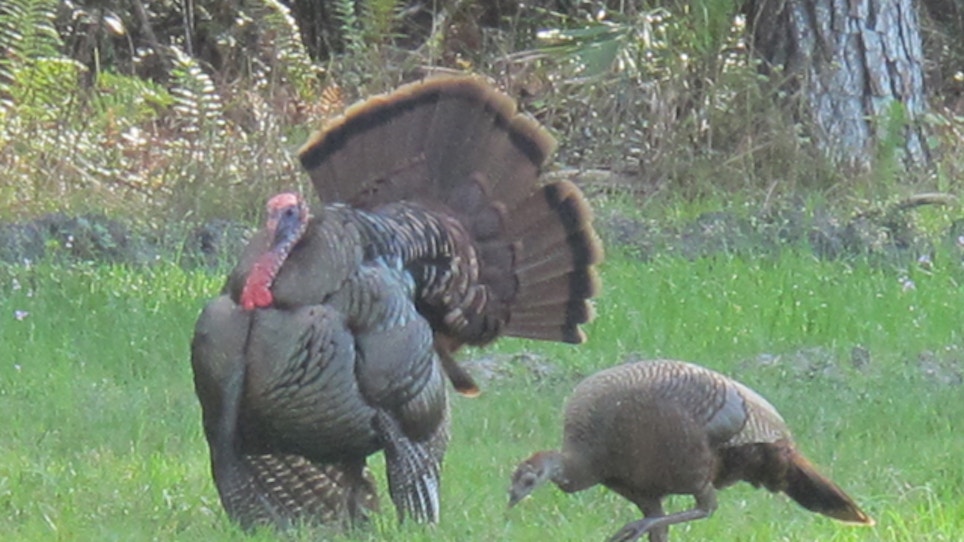By JOHN McCOY? | The Charleston Gazette
CHARLESTON, W.Va. (AP) — As West Virginia transitions from winter to spring, an odd sound begins to echo through the woods.
From the first peek of dawn each day until the last vestiges of daylight disappear, it can be heard. High-pitched yet throaty, steady yet staccato, the distinctive gobble of a tom turkey is a sure-fire sign that the hills are shedding their drab gray coats and donning fresh vestments of springtime green.
Turkeys have lived in the Mountain State for millennia. They were here 11,000 years ago when the first Paleo-Indians migrated into the region, and they in all likelihood will be here for tens of thousands of years to come.
It's difficult to believe, but West Virginia once almost lost its turkeys.
Fewer than 100 years ago, the state's wild flocks had all but been exterminated, and until the 1960s turkeys could be found in only a relative handful of counties.
“In 1923, the total reported turkey kill in the entire state was only 106 birds,” said Curtis Taylor, wildlife chief for the state Division of Natural Resources. “By comparison, last year the combined total for the spring and fall harvests was 12,161.”
The turnabout didn't just happen. In fact, it took more than half a century's worth of governmental intervention, bad science, trial-and-error science and good science to restore thriving populations to all of the state's 55 counties.
The upshot is that today we find turkeys in pretty much all the places the state's early settlers found them.
“The earliest account is of a 1671 (exploration) party that crossed Potts and Peters mountains (in what is now Monroe County) and killed turkeys along the way,” Taylor said. “Another account, of a 1750 expedition down the Ohio River, said the party saw lots of turkeys.
“In fact, early accounts seem to indicate that turkeys were most abundant along rivers. One from the early 1800s said turkeys were easy to find in the Kanawha Valley. Another, from 1822, said turkeys were `very abundant' in the Wheeling area.”
The abundance didn't last. People who settled the state hunted turkeys to put meat on the table. Professional hunters killed untold thousands more and sold them in markets. Finally, an unchecked timber boom took away most of the state's turkey habitat.
“By 1909 (naturalist) Maurice Brooks wrote that turkeys were scarce throughout most of the state,” Taylor said. “Market hunting had been outlawed in 1903, but the logging boom was going strong. By 1922 most of the state had been cut over, and wild turkeys were in very limited numbers. Those were the lean years.”
By then, turkeys were found only in areas so remote or rugged they had yet to be logged.
Taylor said they disappeared from McDowell, Logan, Lincoln, Mingo and Wayne counties by the early 1920s. “By the 1940s, they didn't exist in Boone, Wyoming and Putnam, and they were extremely scarce even in Greenbrier, Monroe and Pocahontas,” he added.
Curiously, turkeys never completely disappeared from Kanawha, Fayette, Raleigh and Summers counties, mainly because the walls of the New River Gorge and upper Kanawha Valley were so rugged hardly anyone dared to venture there.
Conservation officials started trying to restore turkey populations as early as 1928. Problem was, those early efforts involved taking farm-bred turkeys and releasing them to the wild.
“Game farming was in vogue back then,” Taylor said. “Other states were trying it, so we did too. It didn't work. Our records show that from 1933 to 1940, we released 3,075 artificially raised turkeys in good turkey range. They never became established.”
A survey conducted in the early 1940s estimated the statewide turkey population at just 6,000.
In 1947, Conservation Commission officials began using federal wildlife-enhancement funds to try to improve turkey habitat. “They planted grasses, legumes and shrubs, seeded old roads and created water holes,” Taylor said. “In 1950, they did another survey and turned up 7,000 birds.”
One of state's biologists back then, Mercer County native Wayne Bailey, had argued for years that the best way to establish turkey populations would be to trap wild birds from areas with relatively good populations and transport them to turkey-less areas with suitable habitat.
“Bailey finally got his way in 1950,” Taylor said. “He trapped 15 birds and released six of them on Coopers Rock State Forest and nine on the Bluestone Wildlife Management Area. Both of the stockings took. After that, the state started a full-blown turkey (trap-and-transplant) project.”
The stockings remained small-scale for several years because only a few turkeys could be captured at a time. Eventually, Bailey developed a mortar-thrown net that allowed them to capture entire flocks.
“That's when `trap-and-transplant' went into high gear,” Taylor said.
In the early 1970s, state biologists discovered that stockings were even more effective when large numbers of turkeys were released. Where they had been stocking half a dozen to a dozen birds, DNR workers began transplanting 50 or more.
The stockings expanded turkey populations into areas where no wild birds had been seen for decades. In 1989, with a final stocking atop a Logan County mountaintop, wildlife officials announced that viable flocks had been re-established in all 55 Mountain State counties.
Taylor said West Virginia was fortunate that the state never fully lost its turkeys.
“We were one of the very, very few states that had to rebuild a population from scratch,” he said. “What's more, we didn't have to rely on birds from other states to reestablish our own flocks. There has never been a non-West Virginia turkey released in West Virginia. We've sent plenty of our birds to other states, but all our own stockings have been from native birds.”
As a result, the Mountain State is home to birds that are fully adapted to living in the mountains of central Appalachia. Studies have shown West Virginia turkeys to be among the most genetically diverse of their species.
“Now our turkey population has reached a sort of a glass ceiling,” Taylor said. “Population size from year to year is determined by habitat, weather during the nesting season, insect production and other factors like that, just as it was when the first pioneers migrated into the state.
“The story of the wild turkey's comeback in West Virginia is one of the major success stories of modern scientific wildlife management. It's something we should all be proud of.”
___
Information from: The Charleston Gazette, http://www.wvgazette.com






